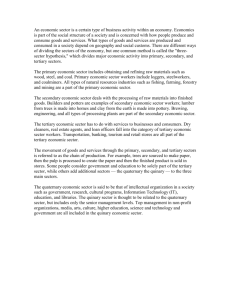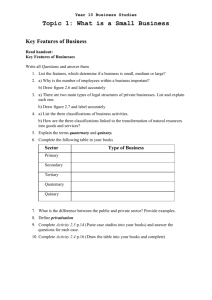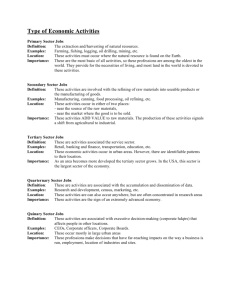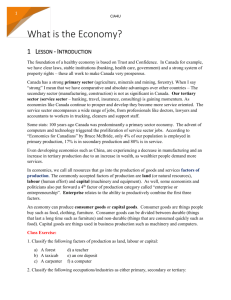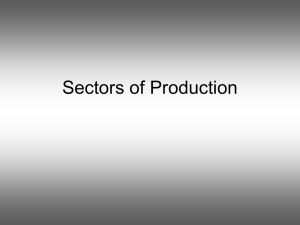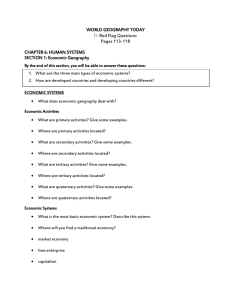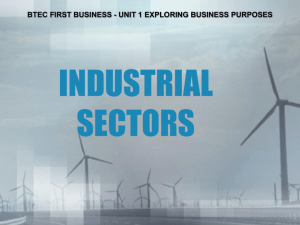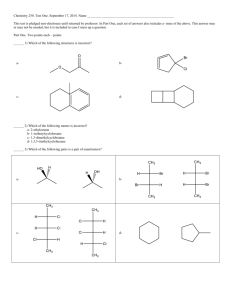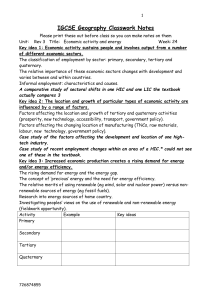CGC1P
advertisement
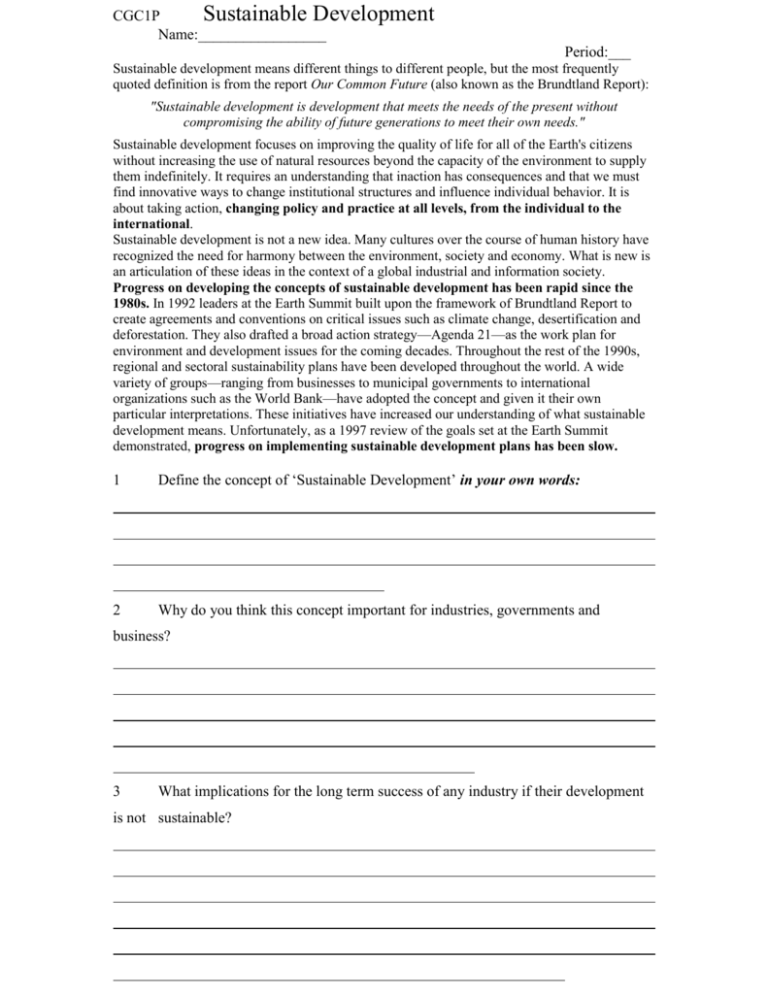
CGC1P Sustainable Development Name:_________________ Period:___ Sustainable development means different things to different people, but the most frequently quoted definition is from the report Our Common Future (also known as the Brundtland Report): "Sustainable development is development that meets the needs of the present without compromising the ability of future generations to meet their own needs." Sustainable development focuses on improving the quality of life for all of the Earth's citizens without increasing the use of natural resources beyond the capacity of the environment to supply them indefinitely. It requires an understanding that inaction has consequences and that we must find innovative ways to change institutional structures and influence individual behavior. It is about taking action, changing policy and practice at all levels, from the individual to the international. Sustainable development is not a new idea. Many cultures over the course of human history have recognized the need for harmony between the environment, society and economy. What is new is an articulation of these ideas in the context of a global industrial and information society. Progress on developing the concepts of sustainable development has been rapid since the 1980s. In 1992 leaders at the Earth Summit built upon the framework of Brundtland Report to create agreements and conventions on critical issues such as climate change, desertification and deforestation. They also drafted a broad action strategy—Agenda 21—as the work plan for environment and development issues for the coming decades. Throughout the rest of the 1990s, regional and sectoral sustainability plans have been developed throughout the world. A wide variety of groups—ranging from businesses to municipal governments to international organizations such as the World Bank—have adopted the concept and given it their own particular interpretations. These initiatives have increased our understanding of what sustainable development means. Unfortunately, as a 1997 review of the goals set at the Earth Summit demonstrated, progress on implementing sustainable development plans has been slow. 1 Define the concept of ‘Sustainable Development’ in your own words: 2 Why do you think this concept important for industries, governments and business? 3 What implications for the long term success of any industry if their development is not sustainable? What Is Industry? Many people think of industry as the collective large-scale manufacturing of goods in well-organized plants with a high degree of automation and specialization. Although this is a common example of industry, it can also include other commercial activities that provide goods and services such as agriculture, transportation, hospitality, and many others. Industry can be classified into different categories or levels for a better understanding of the different types and for making it easier to study. Although many school textbooks list only three levels, more advanced books classify industry into five levels. The terms for each level originate from Latin words referring to the numbers one to five. Levels of Industry Primary (first): Primary industries are those that extract or produce raw materials from which useful items can be made. Extraction of raw materials includes mining activities, forestry, and fishing. Agriculture is also considered a primary industry as it produces “raw materials” that require further processing for human use. EXAMPLES of jobs: Secondary (second): Secondary industries are those that change raw materials into usable products through processing and manufacturing. Bakeries that make flour into bread and factories that change metals and plastics into vehicles are examples of secondary industries. The term “value added” is sometimes applied to processed and manufactured items since the change from a raw material into a usable product has added value to the item. EXAMPLES of jobs: Tertiary (third): Tertiary industries are those that provide essential services and support to allow other levels of industry to function. Often simply called service industries, this level includes transportation, finance, utilities, education, retail, housing, medical, and other services. Since primary and secondary levels of industry cannot function without these services, they are sometimes referred to as “spin-off” industries. Much of the city of Thompson, for example, is made up of tertiary or service industries to support the primary industry of mining. EXAMPLES of jobs: Quaternary (fourth): Quaternary industries are those for the creation and transfer of information, including research and training. Often called information industries, this level has seen dramatic growth as a result of advancements in technology and electronic display and transmission of information. EXAMPLES of jobs: Quinary (fifth): Quinary industries are those that control the industrial and government decision-making processes. This level includes industry executives and management and bureaucrats and elected officials in government. Policies and laws are made and implemented at this level. EXAMPLES of jobs: Structural Transformation of Economic Sectors The distribution of the workforce among the three sectors of an economy can progresses through different stages at different times as follows: First phase: Traditional civilisations – Canada 1600’s to 1900 Workforce quotas: Primary sector: 70% Secondary sector: 20% Non-Industrual society... Tertiary sector: 10% This phase represents a society which is not yet very scientifically developed, with negligble use of machinery. The state of development corresponds to that of European countries in the early Middle Ages, or that of a modern-day developing country. Second phase: Transitional period – Canada 1900 to 1980’s Workforce quotas: Primary sector: 20% Secondary sector: 50% The rise of the Industrial Revolution… Tertiary sector: 30% More machinery is deployed in the primary sector, which reduces the number of workers needed. As a result the demand for machinery production in the second sector increases. The transitional phase begins with an event which can be identified with industrialisation: far-reaching mechanisation (and therefore automisation) of manufacture, such as the use of conveyor belts. The tertiary sector begins to develop, as do the financial sector and the power of the state and government. Third phase: Tertiary civilization – Canada 1980’s to today… Workforce quotas: Primary sector: 10% Secondary sector: 20% The rise of the computer age… Tertiary sector: 70% The primary and secondary sectors are increasingly dominated by automisation, and the demand for workforce numbers falls in these sectors. It is replaced by the growing demands of the tertiary sector. The situation now corresponds to modern-day industrial societies and the society of the future, the service or post-industrial society. Today the tertiary sector has grown to such an enormous size that it is sometimes further divided into an information-based quaternary sector, and even a quinary sector based on non-profit services. Questions: 1. When was Canada in each of the three phases mentioned above? 2. Create three bar graphs showing the Structural Transformation of Economic Sectors changing through time. 3. What trend appears in your graph?
